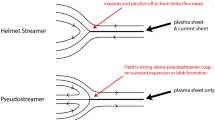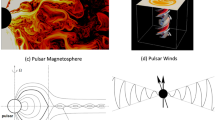Abstract
We consider the Alfvén-Arrhenius fall-down mechanism and describe an approximate model for the infall, capture and distribution of dust particles on a given magnetic field line and their possible neutralization at the ‘2’/3 points, the points at which the field aligned compnents of the gravitational and centrifugal forces are equal and opposite. We find that a small fraction (<10%) of an incoming particle distribution will actually contribute to the above ‘2’/3 fall-down process. We also show that if at the 2/3 points, the ratio of dust to plasma density is
.
(r gμ=radius of a grain in microns,T=plasma temperature in eV), then the dust particles will lose their charge, decouple from the field line and follow Keplerian orbits in accordance with the Alfvén-Arrhenius mechanism.
We then determine the limits on the plasma parameters in order that rotation of a quasi-neutral plasma in thermal equilibrium be possible in the gravitational and dipole field of a rotating central body. The constraints imposed by the above conditions are rather weak, and the plasma parameters can have a wide range of values. For a plasma corotating with an angular velocity Ω∼10−4s−1, we show that the plasma temperature and density must satisfy
.
Similar content being viewed by others
References
Alexander, A. F. O'D.: 1953,Brit. Astron. Assoc. J. 64, 26.
Alexander, A. F. O'D.: 1962,The Planet Saturn, a History of Observation, Theory and Discovery, Macmillan, New York.
Alfvén, H. and Arrhenius, G.: 1976,Evolution of the Solar System, NASA SP-345.
Baxter, D. and Thompson, W. B.: 1971, ‘Jet Stream Formation Through Inelastic Collisions’, in T. Gehrels (ed.),Physical Studies of Minor Planets, NASA SP-207.
Baxter, D. and Thompson, W. B.: 1973,Astrophys. J. 183, 323.
Goretz, C. K. and Ip, W.-H.: 1984,Geophys. Res. Letters. 11, 349.
Mendis, D. A. and Axford, W. L.: 1974,Rev. Earth Planetary Sci. 2, 419.
Mendis, D. A., Northrop, T. G., and Whipple, E. C.: 1985,J. Geophys. Res. 40, 7405.
Whipple, E. C.: 1981,Rep. Progress Phys. 44, 1197.
Author information
Authors and Affiliations
Additional information
Paper dedicated to Professor Hannes Alfvén on the occasion of his 80th birthday, 30 May 1988.
Rights and permissions
About this article
Cite this article
Azar, M., Thompson, W.B. The cosmogonic shadow effect. Astrophys Space Sci 144, 373–406 (1988). https://doi.org/10.1007/BF00793194
Received:
Issue Date:
DOI: https://doi.org/10.1007/BF00793194




